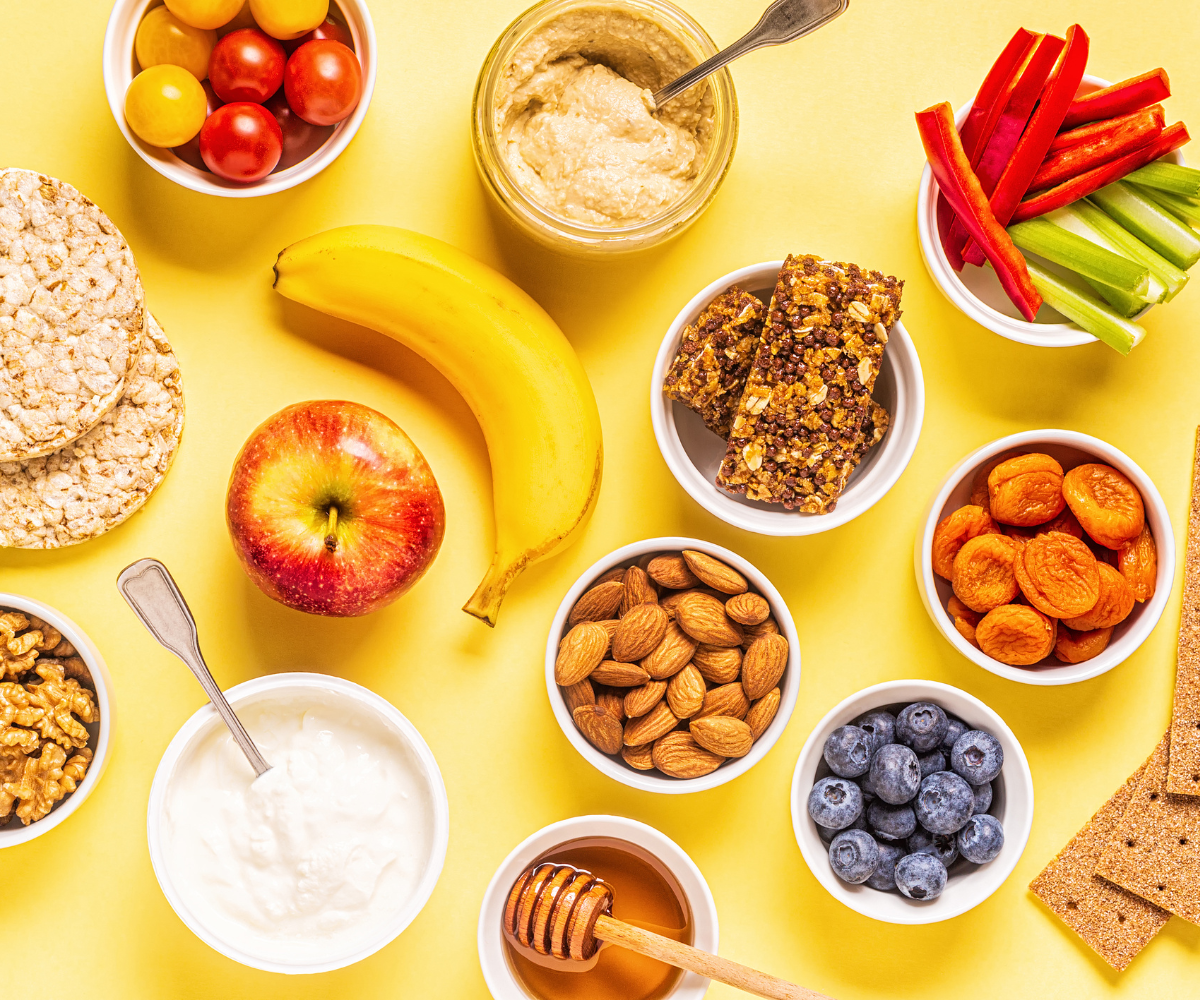Steady energy, a positive mood, less severe morning sickness, feeling connected to your body… that all sounds great, right? I’m with you! This is what it can feel like when your blood sugar is balanced throughout your pregnancy.
It’s very important to have some level of sugar in your blood at all times. Blood sugar that’s too low is super risky and can be life-threatening. Chronically elevated blood sugar can also pose health risks – in pregnancy and otherwise.
When blood sugar is out of optimal range – either too high, too low, or swinging between the two, you might notice:
- Fatigue and lethargy
- Feeling anxious or on-edge
- Erratic appetite or intense cravings
- Feeling dizzy or lightheaded
- Mood swings
The good news is that unless you have diabetes, your body is probably doing a good job of managing blood sugar on its own. Most people don’t have to worry so much about blood sugar that they’re checking their levels all day long.
Even so, non-diabetic individuals can still experience some of the symptoms of large swings in blood sugar. This is especially true if eating patterns are disordered or irregular.
PCOS (Polycystic Ovarian Syndrome) is associated with increased insulin resistance, which results in elevated blood sugar even if the pancreas is working normally. That means that the body’s cells need more help “soaking up” glucose from the bloodstream even in the presence of the hormone insulin.
Others may experience hypoglycemia (low blood sugar) when the pancreas produces more insulin than needed after a meal or snack. Hypoglycemia can also occur due to malnutrition related to an eating disorder.
And if you do have diabetes – type 1, type 2, or gestational diabetes – working with your body to find gentle nutrition strategies that support healthy blood sugar is quite important. Depending on your situation, this might look like matching insulin dosing to the carbohydrate content of your meal, being sure to eat consistently throughout the day (and not go too long without food), adding in missing nutrients to your plate, and/or incorporating gentle movement more frequently in your day.
Ultimately, eating to support balanced blood sugar is really just a more fancy way of talking about eating in a way that provides steady, consistent energy all day long. There are a few other things that can help improve blood sugar balance including: movement, reducing stress, good sleep hygiene, and targeted nutrients/supplements. But this post is primarily going to cover the food piece.
Keep reading to learn more!
Why is blood sugar balance in pregnancy important?
Maintaining a stable amount of glucose in the bloodstream is important both for mom’s health and for the growing baby’s, too.
Like in the case of gestational diabetes, too much glucose can lead the fetus to produce more insulin than it needs once it’s born. This can lead to hypoglycemia for the infant after delivery. It can also cause the baby to grow more quickly while in-utero, leading to a baby that may be “too big” for mom’s body to deliver through her pelvis safely, potentially leading to complications during labor and delivery via C-section. Unmanaged gestational diabetes is also associated with an increased risk of gestational hypertension, which can progress to pre-eclampsia.
On the other hand, low blood sugar can cause mom to feel more tired, lightheaded and nauseous, worsening many of the discomforts of pregnancy. Swinging between high and low blood sugar is taxing for the body, and doesn’t feel great, either.
If you have gestational diabetes, it’s important to find ways to work with your body to keep blood sugar steady throughout your pregnancy. And regardless of your diagnosis, working to eat in a way that supports stable blood sugar can help you feel energized, less nauseous, and less anxious overall.
How do you balance blood sugar?
When you eat a meal that contains carbohydrates, the body works to break them down into the smallest absorbable particles – glucose. Foods that are high in fiber, protein, and fat, slow this process down, while foods that are primarily “simple” sugars (low in fiber, protein and fat), absorb into the bloodstream quickly.
The pancreas is the first to detect glucose in the blood, and releases the hormone insulin in response. Insulin tells cells in the body to take in glucose from the bloodstream, which provides energy to the cell and lowers the glucose concentration in the blood.
Now, in order for this process to work well, a few things are needed:
- The pancreas has to be able to release insulin. In Type 1 diabetes, the pancreas does not release insulin so the cells don’t get glucose and the blood is overly concentrated with glucose.
- Cells need to respond appropriately to insulin. If the cells aren’t able to identify insulin or produce insulin receptors, the cells won’t absorb glucose and blood sugar will remain elevated despite the presence of insulin.
- The body needs a steady supply of glucose. Erratic eating patterns, unbalanced meals and snacks, or inadequate intake can lead to imbalances in blood sugar.
Balancing blood sugar starts with understanding the unique needs of your body. General strategies for optimizing insulin sensitivity and blood sugar balance include:
- Eating consistently – about every three hours
- Achieving a balance of macronutrients: protein, fat and carbohydrate
- Prioritizing intake of minerals (sodium, potassium, magnesium, selenium etc.)
- Increasing fiber intake
- Embracing colorful produce rich in polyphenols
- Incorporating gentle movement
- Getting high quality sleep
- Addressing sources of stress
5 Snack Ideas to Help Promote Blood Sugar Balance
Cheese and Fruit Plates
Cheese is one of my favorite ways to get protein and fat during pregnancy. It’s typically well-tolerated, contains important amino acids and minerals, and is a good source of calcium. Pairing cheese with your favorite fruits (especially those where you eat the skin, like grapes or apples) can be tasty and satisfying, and is also a great combination for blood sugar balance.
Try: Cheddar Cheese with Apple Slices, Swiss Cheese with Grapes, Brie Cheese with Pear Slices, or Goat Cheese with Berries.
Loaded Greek Yogurt Bowls
Like cheese, Greek yogurt provides calcium, minerals, protein and fat (I recommend full fat yogurt here!). Plain Greek yogurt is a great blank canvas for adding your favorite flavors and textures. Fruit, cereal and/or granola can add carbohydrates and fiber, while sprinkling on nuts and seeds can amp up the nourishing fat + protein factor. Try a drizzle of honey or maple syrup for a little extra sweetness – the protein and fat in the rest of the snack help to soften the glycemic load.
Try: Plain Greek Yogurt, Whole Grain Cereal and Berries. Top with nuts and seeds (pumpkin, chia, hemp, sunflower, almond, walnut, peanuts, pecans, etc.)
Cucumber Sandwiches
Refreshing, soothing and delicious! Cucumber sandwiches can make for a fun change of pace during snack time. The creamy cream cheese and cool cucumbers stand up well to nutty (higher fiber) whole grain bread, which is what I recommend for blood sugar balance. Choose full fat cream cheese, which will help promote satisfaction and help prevent blood sugar from rising too quickly. I like to sprinkle some everything bagel seasoning on top of mine, but that’s just me. Slice in quarters and imagine you’re at a fancy tea!
Veggie Dippers with Hummus
A classic for a reason, veggies and hummus is a great snack option for those who prefer something on the savory side. Some of my favorite veggies to dip in hummus include pepper slices, cucumber slices, carrots, and green beans – but choose your own adventure. Hummus is typically made with chickpeas and olive oil so it has a good combo of protein + fat + fiber to provide a steady rise in blood sugar. Feel free to add in a few pita chips or pretzels for a salty crunch, too!
Not a fan of hummus? Try refried beans or 7-layer dip for a different spin.
On The Go Options
Not everyone has the ability to enjoy snacks peacefully at home or while sitting down. Sometimes you have to find a way to feed yourself on the go! This is where convenient, packaged options can be the best choice – because something is better than nothing! In order to aim for balanced blood sugar on the go, try to find a balance of protein, fat and carbs. Here are some of my favorite on-the-go combos:
- Perfect Bars
- Protein Bar (ie. Quest, Builder’s Bar, ONE, Misfits, Aloha, etc.) and Banana
- Granola Bar (ie. Nature Valley, Clif Bar, Kind Bar, Lara Bar, etc.) and Milk
- Cheese stick (or 2) and Apple
- Trail Mix
- Jerky & Dried Fruit
- Drinkable yogurt + Mixed Nuts
Wrapping it up
When it comes to eating to support your blood sugar, I also want to make sure we’re prioritizing your relationship with food. Realize that NO food is off limits. Often the foods that are most demonized when it comes to blood sugar balance are also those that diet culture labels as “toxic” or “poison,” so it can feel like you have zero permission to eat them.
Remember that it’s the dose that makes the poison. It’s just as unhealthy to eat too much spinach or broccoli as it is to eat too much sugar. Blood sugar balance is about so much more than simply “how much sugar” you are eating at a meal or snack – the biggest piece is what ELSE you are eating with the foods that contain sugar that can help your body better utilize the carbs.
Allowing yourself to enjoy the foods you love during pregnancy can help you feel less deprived and out of control around those foods later on. (sidenote: binge eating, which is often a consequence of restriction, is decidedly not great for blood sugar).
For additional support in learning how to eat (and live!) in a way that supports your blood sugar AND your relationship with food, consider working with me! Learn how to become a client by reaching out and sending me a message. You deserve to be supported and I can’t wait to help you.

